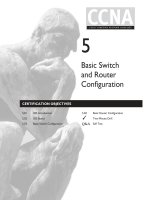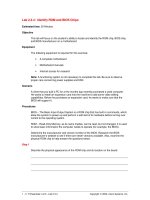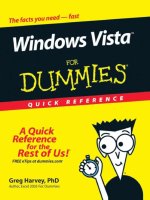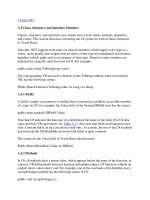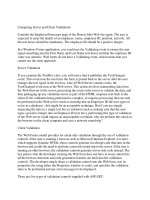Tài liệu Java Testing and Design- P1 docx
Bạn đang xem bản rút gọn của tài liệu. Xem và tải ngay bản đầy đủ của tài liệu tại đây (826.19 KB, 50 trang )
“The new software testing methods introduced in this book will show you how to form and apply
effective online goal-directed design and testing techniques. You begin with your user’s goals, follow
Frank’s recommendations for scalable system design, and end with powerful tests that measure your
user’s success in achieving them.”
—Alan Cooper,
Author of About Face 2.0: The Essentials of Interaction Design
and The Inmates Are Running the Asylum.
He is also the father of Visual Basic
“A must read for Java developers needing to deliver high-quality, scalable, and well performing
production Web Services.”
—Phil Goodwin,
Staff Engineer, JAX Team, Sun Microsystems, Inc.
“Testing, scalability, and test-driven design and methodologies are the new ‘battlefield’ of software
development. Frank Cohen introduces a new methodology for designing, testing, and maintaining
Web-enabled applications. This book is the best battlegear available.”
—Andrew Sliwkowski,
Performance Analyst, BEA Systems
“Frank uses his considerable experience in information system technology to provide a view of the
evolution from mainframe to Client/Server to distributed ‘n’ or ‘flapjack’ tier architectures, structured
to object-oriented design, and waterfall to Agile/Scrum/XP development approaches. Now that we (as
an industry) have moved toward this distributed, open environment—testing, scalability, and
interoperability are the next challenges, and Frank’s book is an excellent introduction.”
—Ed Hunter,
SunOne Performance Team, Sun Microsystems, Inc.
“The book is an excellent presentation of metrics and measurement approaches to harnessing and
calculating performance and functionality when working with Web-enabled applications, especially
Web Services. The book’s emphasis on user archetypes to drive otherwise headless testing agents is
a key point.”
—Bret Pettichord,
Software Testing and Test Automation Guru for IBM/Tivoli, BMC, Segue,
Interleaf; and co-author of Lessons Learned in Software Testing
“Frank Cohen’s new book takes a theoretical, didactic, and empirical approach to attacking this
issue and does a fantastic job at bringing both the novice and expert from the ‘what and why’ to the
‘how’ of software testing design, automation, and scalability/reusability.”
—Christian J. Hessler
Staff Engineer, Sun Microsystems, Inc.
“An unequaled achievement in clarity of Java testing, design, and optimization. To avoid hard-to-
trace scalability and performance ‘gotchas’ inherent in early Java development, this book is for you!”
—Farooq Khan,
Software Development Manager, 2Wire Inc.
“What I liked most about this book was the confidence with which Cohen presents a wide range of
topics: objects, tests, architecture, frameworks, and design—all the right stuff for a software
developer, QA technician, and IT manager.”
—Rossana Muriel,
Director of Quality, Advise & Services, AMP Global Assets Management
PH069-Cohen.book Page i Monday, March 15, 2004 9:00 AM
Please purchase PDF Split-Merge on www.verypdf.com to remove this watermark.
PH069-Cohen.book Page ii Monday, March 15, 2004 9:00 AM
Please purchase PDF Split-Merge on www.verypdf.com to remove this watermark.
P
RENTICE
H
ALL
PTR
U
PPER
S
ADDLE
R
IVER
, NJ 07458
WWW
.
PHPTR
.
COM
PRENTICE HALL
PROFESSIONAL TECHNICAL REFERENCE
UPPER SADDLE RIVER, NJ 07458
WWW.PHPTR.COM
Java
™
Testing
and Design
From Unit Testing
to Automated Web Tests
Frank Cohen
PH069-Cohen.book Page iii Monday, March 15, 2004 9:00 AM
Please purchase PDF Split-Merge on www.verypdf.com to remove this watermark.
To Lorette—truly, deeply, madly
❖ ❖ ❖
A CIP catalog reference for this book can be obtained from the Library of Congress
Editorial/Production Supervision:
MetroVoice Publishing Services
Executive Editor:
Greg Doench
Marketing Manager:
Chris Guzikowski
Manufacturing Manager:
Alexis Heydt-Long
Cover Designer:
Nina Scuderi
Cover Design Director:
Jerry Votta
Series Designer:
Gail Cocker-Bogusz
Full-Service Project Manager:
Anne R. Garcia
© 2004 by Pearson Education, Inc.
Publishing as Prentice Hall Professional Technical Reference
Upper Saddle River, New Jersey 07458
Prentice Hall PTR offers excellent discounts on this book when ordered in quantity for bulk
purchases or special sales. For more information, please contact: U.S. Corporate and Government Sales,
1-800-382-3419, For sales outside of the U.S.,
please contact: International Sales, 1-317-581-3793,
All company and product names mentioned herein are the trademarks or registered trademarks
of their respective owners.
All rights reserved. No part of this book may be
reproduced, in any form or by any means,
without permission in writing from the publisher.
Printed in the United States of America
First Printing
ISBN 0-13-142189-1
Pearson Education LTD.
Pearson Education Australia PTY, Limited
Pearson Education Singapore, Pte. Ltd.
Pearson Education North Asia Ltd.
Pearson Education Canada, Ltd.
Pearson Educación de Mexico, S.A. de C.V.
Pearson Education—Japan
Pearson Education Malaysia, Pte. Ltd
.
PH069-Cohen.book Page iv Monday, March 15, 2004 9:00 AM
Please purchase PDF Split-Merge on www.verypdf.com to remove this watermark.
v
Chapter
Contents
Foreword xiii
Preface xv
Acknowledgments xix
PART I
Gauging Web-Enabled Applications
CHAPTER 1
The Forces at Work Affecting Your Web-Enabled Software 1
The First Three Axioms 2
Web-Enabled Applications, the New Frontier 4
Why Writing High-Quality Software Today Is Hard 10
The Myth of Version 2.0 Solidity 11
Management’s Quest for Grail 12
Trying for Homogeneity When Heterogeneity Rules 15
The Language of Bugs 17
The Evil Twin Vice Presidents Problem 18
A Concise History of Software Development 19
Web-Enabled Applications 20
Test Paradigms and Lifecycle Processes 22
Testing Methods 25
Click-Stream Testing 26
Unit Testing 27
Functional System Testing 28
Scalability and Performance Testing 30
Quality of Service Testing 30
PH069-Cohen.book Page v Monday, March 15, 2004 9:00 AM
Please purchase PDF Split-Merge on www.verypdf.com to remove this watermark.
vi Contents
Defining Test Agents 30
Scalability and Performance Testing with Test Agents 33
Testing for the Single User 35
Creating Intelligent Test Agents 38
Automated Testing 39
Summary 39
CHAPTER 2
When Application Performance Becomes a Problem 41
Just What Are Criteria? 41
Defining Criteria for Good Web Performance 44
Are the Features Working? 46
Is Performance Acceptable? 46
How Often Does It Fail? 46
Web-Enabled Application Measurement Tools 46
The Web Rubric 47
The Four Tests of Good Performance 49
Components of a Good Test Agent 50
Web-Enabled Application Types 51
The Web-Enabled Application Points System (WAPS) 53
The Web-Enabled Application’s Framework 57
The Flapjacks Architecture 57
Adopting Flapjacks and Intelligent Test Agents 59
Building Intelligent Test Agents in a Flapjacks Environment 64
Script Languages and Test Agents 66
Generating Meaningful Data 75
Summary 76
CHAPTER 3
Modeling Tests 77
Modeling User Behavior for Meaningful Test Results 78
Lifecycles, Projects, and Human Nature 80
The Micromax Lifecycle 83
Categorizing Problems 83
Prioritizing Problems 85
Reporting Problems 86
Criteria for Evaluating Problems 86
Considerations for Web-Enabled Application Tests 87
Functionality and Scalability Testing 87
Functional Testing 90
PH069-Cohen.book Page vi Monday, March 15, 2004 9:00 AM
Please purchase PDF Split-Merge on www.verypdf.com to remove this watermark.
Contents vii
Scalability Testing 91
Testing Modules for Functionality and Scalability 92
Management Styles 99
Service Level Agreements 101
Grid Computing and Intelligent Agents 104
The Road to Easy Setup, Use, and Maintenance 105
Self-Healing Systems 106
Understanding Performance and Scalability Criteria 108
Defining SPC 108
SPC in Action 111
Modeling a User’s Goals 115
Test States 117
Using UML and Code Comments to Model Tests 118
Putting the Test Together 119
Summary 120
CHAPTER 4
Java Development and Test Automation Tools 121
The Three Waves 122
Desktop Application Development and Test Automation 122
Client/Server Development and Test Automation 124
Web-Enabled Development and Test Automation 127
Achieving the Troika—the Fourth Wave 131
A Test Automation Lifecycle 133
Summary 137
CHAPTER 5
Bridging from Methodology to Design 139
Searching for Tools to Enable the Troika 140
How to Get TestMaker 144
TestMaker and the Open Source Process 145
Spending Five Minutes with TestMaker 146
Installing TestMaker on a Windows or Linux Computer 147
Running TestMaker 148
Getting to Know the TestMaker Graphic Environment 148
Opening and Running Test Agents 150
Building Agents with the New Agent Wizard 153
Why I Like Jython 162
1. Jython Is Quick 163
2. Data Structures and List Iteration Come for Free 163
3. Dynamic Variables with Automatic Typing 164
4. Functions Are First Class 164
PH069-Cohen.book Page vii Monday, March 15, 2004 9:00 AM
Please purchase PDF Split-Merge on www.verypdf.com to remove this watermark.
viii Contents
5. Java Integration 165
6. Bean Property Introspection 165
7. Sun Is Adopting Scripting in Java 166
Using Jython to Incorporate JUnit 166
JUnit for Repeatable Tests 166
A JUnit Example 167
JUnit and TestMaker 169
Summary 172
PART II
Components, Interoperability, and Optimization
CHAPTER 6
Design and Test in HTTP/HTML Environments 173
The HTTP/HTML Environment 174
What Usually Goes Wrong 177
Compliance, As in Non, and Browser Caching 177
Invalid Data 179
Session Problems 181
Constructing HTTP Test Agents 181
Hands-On HTTP Communication 184
Understanding Cookies, Sessions, and Redirection 193
Validating Response Data 203
Summary 214
CHAPTER 7
Tuning SOAP and XML Web Services 217
The Web Services Vision 218
XML-RPC for Web Interoperability 221
Where XML-RPC Falls Short 227
Universal Interoperability with SOAP 227
Web Service Scalability Techniques 229
Web Service Interoperability Problems 231
Discovery 232
Definition 232
Request/Response 234
On the Horizon 237
Using TestMaker to Understand WSDL 237
Constructing SOAP Calls 242
Different Types of SOAP Calls 245
PH069-Cohen.book Page viii Monday, March 15, 2004 9:00 AM
Please purchase PDF Split-Merge on www.verypdf.com to remove this watermark.
Contents ix
Validating Response Data 254
Making It Easier to Write Agents 255
Resources 255
Summary 256
CHAPTER 8
State, Design, and Testing 257
A Question of State 257
Lifecycle for Testing Stateful Systems 261
Techniques to Establish State 263
Preparation and Setup Agents 267
Setup_agent 273
Using Databases to Configure Tests 280
Using Lingo to Make Test Content
Close to Real 286
Summary 291
CHAPTER 9
Integrating with .NET Web Services 293
Interoperability and Integration 295
How Is .NET Different? 297
Document-Style Scalability 300
SOAP Headers in .NET 302
WSDL .NET Style 304
A Test Agent for .NET Environments 307
Near Term Considerations 315
Summary 316
CHAPTER 10
Building and Testing Intranets and Secure Environments 319
Getting a Head Start 319
Security by Routing 320
Virtual Private Networks 322
Network Segments and Subnets 323
Transport Security 325
SOAP over SSL 330
.NET Passport Authentication 331
HTTP Basic Authentication 332
SOAP and Security 333
PH069-Cohen.book Page ix Monday, March 15, 2004 9:00 AM
Please purchase PDF Split-Merge on www.verypdf.com to remove this watermark.
x Contents
Generating Certificates and KeyStores 336
The Java Keytool 339
Summary 341
CHAPTER 11
A Web Application Framework from Construction to Test 343
The Trading Desk and Intelligent Test Agents 343
Scalability Test Goals 344
System Infrastructure 345
User Archetypes 348
Understanding the Test Requirements 350
Constructing the Test 352
Implementing User Archetypes in Code Modules 356
Implementing the Master Component 365
Setup 366
Run 368
Cleanup 371
Property Files for Test Configuration 371
Implementing the Logging Component 372
Avoiding Test Scalability Problems 374
A First Look at the Results 376
Summary 377
CHAPTER 12
Turning Test Agent Results into Actionable Knowledge 379
What to Expect from Results Analysis 380
Goal: Our New Web Site Needs to Handle Peak Loads of 50 Concurrent Users 381
Goal: The Web Site Registration Page Needs to Work Flawlessly 381
Goal: Customer Requests for Month-End Reports Must Not Slow Down the
Order-Entry Service 382
Goal Summary 383
The Big Five Problem Patterns 383
Resource Problems 383
Concurrency Problems 384
Component Problems 386
Contention Problems 387
Crash Recovery Problems 388
Key Factors in Results Analysis 389
Scenarios Where Results Data Misleads 391
The Node Problem 391
The Hidden Error 392
PH069-Cohen.book Page x Monday, March 15, 2004 9:00 AM
Please purchase PDF Split-Merge on www.verypdf.com to remove this watermark.
Contents xi
Dileep’s Dilemma 393
Diminishing Returns 394
Back to the Stock Trading Example 394
Implementing the Tally Agent 394
Summary 399
PART III
Case Studies: Building Reliable Applications
CHAPTER 13
Concurrency and Scalability in a High-Volume Datacenter 401
Introduction 401
The 2Wire Component Management System 402
Understanding What Happens over the Wire 404
Testing in a Complex Environment 407
The Test Method 411
Test Environment Considerations 414
Constraints in the Test Environment 416
Summary 417
CHAPTER 14
Making the Right Choices for SOAP Scalability 419
Why is SOAP So Popular? 419
SOAP Encoding Styles 421
Simple Object Access Needs Simple Testing 424
Should You Let the Tools Do the Driving? 428
May I Freak Out Now? 428
The Performance Kit 429
How Do I Get the Performance Kit? 430
Installing the Performance Kit 431
Getting Started 432
Some Other Things We Found 445
Summary 446
CHAPTER 15
Multiprotocol Testing in an Email Environment 447
Needs and Benefits 447
Scoping the Project 448
PH069-Cohen.book Page xi Monday, March 15, 2004 9:00 AM
Please purchase PDF Split-Merge on www.verypdf.com to remove this watermark.
xii Contents
Test Design and Methodology 451
User Archetypes 453
Installation and Configuration 455
From Archetypes to Test Agent Scripts 456
Building Muriel 457
Building Marilyn 461
Result Analysis 476
Summary 477
Index 479
PH069-Cohen.book Page xii Monday, March 15, 2004 9:00 AM
Please purchase PDF Split-Merge on www.verypdf.com to remove this watermark.
xiii
Chapter
Foreword
he ultimate test of every software construction effort is the user’s success
using the product to accomplish some practical goal. No matter how
much state-of-the-art technology goes into the software, success can only be
judged through the lens of the user.
Taking this philosophy to heart, Frank Cohen has created and led a thriv-
ing open-source project called TestMaker. It has improved the day-to-day
lives of thousands of software programmers, quality assurance technicians,
and information technology managers.
Since 1990, my company, Cooper Software, has pioneered the Goal-
Directed method of interaction design. This powerful and effective method
has met with widespread acceptance in the interaction design community. It
is heartening to see how Frank has applied these same methods to software
test automation and scalable system design. Frank’s application of these
methods is especially important in today’s environments where J2EE, .NET,
and the latest integration technologies are used to build information systems.
The new software testing methods introduced in this book will show you
how to form and apply effective online goal-directed design and testing tech-
niques. You begin with your user’s goals, follow Frank’s recommendations for
scalable system design, and end with powerful tests that measure your user’s
success in achieving them.
As a programmer, quality assurance technician, or IT manager, you have
several choices of system design, automated test tools, and techniques. The
T
PH069-Cohen.book Page xiii Monday, March 15, 2004 9:00 AM
Please purchase PDF Split-Merge on www.verypdf.com to remove this watermark.
xiv Foreword
lessons in this book not only present a coherent methodology, but provide
you with immediately useful tools, techniques, and code that will automate
the testing of your Web-enabled applications, especially Web Services.
Frank Cohen has been leading entrepreneurial software creation efforts
for more than 25 years. With this book you can take advantage of his exten-
sive experience helping users achieve their goals.
—Alan Cooper
Chairman, Cooper Software
Alan is the author of About Face 2.0: The Essentials of Interaction Design and
The Inmates Are Running the Asylum. He is also the father of Visual Basic.
PH069-Cohen.book Page xiv Monday, March 15, 2004 9:00 AM
Please purchase PDF Split-Merge on www.verypdf.com to remove this watermark.
xv
Chapter
Preface
ow that you have finished learning the basics of programming, testing,
and application software development, you are ready for the next step.
Web infrastructure (routed networks using open protocols in a grid of inex-
pensive equipment) is everywhere. And yet, until this book, there was no
guide to show how your choices in design, coding, and testing impact the
scalability, performance, and functionality of your Web-enabled applications.
This book will show you a fast and efficient method to go from basic Java
knowledge to building production-worthy, scalable, and high-performing
Web-enabled applications.
I wrote this book for software developers, QA technicians, and IT manag-
ers working in large corporate IT groups, software development companies,
and service providers. It expands on other software development books by
going from architectural discussions to showing actual working code that you
can use in your own environment. The case studies show real-world practical
techniques to make software projects reliable, scalable, and secure.
This book prepares software developers for a laundry list of new APIs,
protocols, and tools being packed into the next generation of J2EE, .NET,
and open-source systems. While these new software libraries, tools, and tech-
niques are a big move forward for all of us, they push software developers,
QA technicians, and IT managers to learn even more technology to turn out
complex, highly functional, and interoperable software applications.
N
PH069-Cohen.book Page xv Monday, March 15, 2004 9:00 AM
Please purchase PDF Split-Merge on www.verypdf.com to remove this watermark.
xvi Preface
This book then gears you up to adopt the next generation of Web proto-
cols, including Web Service Interoperability (WS-I,) Security Assertion
Markup Language (SAML), Electronic Business using eXtensible Markup
Language (ebXML,) and Liberty Alliance. Tools from technology vendors
(for example, BEA WebLogic Server, IBM WebSphere, Sun Java System
(formerly Sun One), and Microsoft .NET) are on the move. All this innova-
tion gives pause to a software developer, QA technician, and IT manager. In
these environments, each choice of tool, protocol, platform, and technique
you make impacts system scalability and reliability.
I wrote this book from my experiences as the “go-to” guy for enterprises
that need to test and solve problems in complex interoperating information
systems, especially Web Services. This book contains a treasure of knowl-
edge, tips, and techniques and is applied with a solid methodology from the
more than 50,000 software developers, QA technicians, and IT managers that
participate in my TestMaker open-source project. Details are found at http://
www.PushToTest.com, the Web-based community meeting place where
ideas on software design, testing, and automation are exchanged every day.
In this book, I describe the architectural choices to build Web-enabled
applications in Java and show how each choice impacts scalability and reli-
ability. I show how to test and optimize these systems in your own environ-
ment. I describe the need for intelligent test agents in Web-enabled
environments, describe a test agent framework with a tutorial on the latest
Web-based test techniques, and present TestMaker, my free open-source
framework for building intelligent test agents to check Java-based Web soft-
ware for performance, scalability, and reliability. I present case studies and
immediately useful code of how Elsevier Science, 2Wire, Sun Microsystems,
and BEA successfully use intelligent test agent technology to build scalable
Java applications and ensure confidence in their Web-enabled Java projects.
Inside you will find in-depth discussions of a powerful, proven Web-
enabled Java architecture, construction techniques, immediately useful code,
and intelligent test agents to check Web-enabled applications for scalability,
functionality, and reliability.
• Java and J2EE-based dynamic database-driven Web-enabled
architecture
• Integrated applications using SOAP, XML-RPC, .NET, HTTP,
HTTPS protocols
• J2EE and .NET Interoperability problems solved
PH069-Cohen.book Page xvi Monday, March 15, 2004 9:00 AM
Please purchase PDF Split-Merge on www.verypdf.com to remove this watermark.
Preface xvii
• Performance Kits for developers in BEA WebLogic, IBM
WebSphere, SunONE
•eCommerce site architecture and optimization
• Secure Internet services using Public Key Infrastructure (PKI),
HTTPS, SSL
•Building with the next-generation security technologies: WS-I,
SAML, Liberty
•Avoiding and solving concurrency problems
•Architecture, code, and test agents for J2EE, Java Web
Services, P2P, .NET
•Easy-to-understand test scripts using Python/Jython and Java
•Extended architectures include email protocols (IMAP, SMTP,
POP3) applications
The PushToTest Web site supports this book with an active community of
users. The Web site contains all of the book’s source code and applications,
ready to be expanded and customized to meet your needs to build reliable
and scalable Web-enabled applications in Java.
I hope this helps.
—Frank Cohen
PH069-Cohen.book Page xvii Monday, March 15, 2004 9:00 AM
Please purchase PDF Split-Merge on www.verypdf.com to remove this watermark.
PH069-Cohen.book Page xviii Monday, March 15, 2004 9:00 AM
Please purchase PDF Split-Merge on www.verypdf.com to remove this watermark.
xix
Chapter
Acknowledgments
o man is an island,” so said the English poet John Donne. In my experi-
ence writing this book, I learned that no book is an island either. This
book is the culmination of thousands of people’s work to improve the way we
build and test Web-enabled application software. Each of you provided your
feedback, comments, and suggestions. For me the experience has been richly
rewarding. I hope it will be rewarding for you too.
There are many people who I would like to specifically highlight for their
contributions. My lovely wife, Lorette, supported me on all those sleepless
nights and with her thoughts and opinions on how the book should be struc-
tured. My children, Jack and Madeline, missed many nights and weekends
with me as I disappeared down that rabbit-hole of a home office. Thank you,
and I love you more than molasses.
Geoff Lane came up with the original idea to put my test tool, TestMaker,
into open-source distribution. He architected the Test Object Oriented Library
(TOOL) in TestMaker and continues to provide his brilliant thought to the
project. Because of his technical editing I covered new subjects and expanded
coverage throughout the book.
Todd Bradfute has become my major collaborator in TestNetwork, a com-
mercial version of TestMaker. His feedback and designs for a distributed test
environment have helped this book greatly.
Darin MacBeath of Elsevier found the problems with SOAP RPC scalabil-
ity that are highlighted in this book. To my knowledge Darin’s designs for a
“
N
PH069-Cohen.book Page xix Monday, March 15, 2004 9:00 AM
Please purchase PDF Split-Merge on www.verypdf.com to remove this watermark.
xx Acknowledgments
next-generation content publishing engine that uses SOAP as a means to
publish APIs was the first SOAP-based Web service in production.
Alan Cooper taught me the Goal-Directed interaction-design method he
invented and encouraged me to write this book.
For helping me deliver this book: Marc Farley (mentor), Carole McClendon
(agent), Karen McLean (editor), and Jeff Mason (coxswain). The technical edi-
tors provided excellent feedback: Christian J. Hessler, Eben Hewitt, and John
Mueller. The readers provided their insight: Paul Gerken and Philbert Canon.
For encouraging me to write this book, my late Aunt Betsy Hilbert, herself
published many times over.
For their support of TestMaker I thank: Eric Brown, Farooq Kahn,
Ronald Tschaler, Linda Bissum, and Bao Nguyen at 2Wire; Dileep Kumar,
Madhu Konda, Rohit Valia, Robin Smith, and Deborah Andrade of the
SunONE team at Sun Microsystems; Phil Goodwin and Jeff Sutor on the
Java engineering team at Sun Microsystems; Michael Smith, Eric Stahl, Scott
Regan, Sam Ramji, Samir Kothari, Michael Bamford, Michael Smith, and
Andrew Sliwkowski at BEA Systems; Karen Lee, Deborah Magid, Rod
Smith, Rawn Shah, and John Swanson at IBM. PJ Murray and Robert
Schneider at CapeClear; Robert Scoble at Userland; Rossana Muriel and
Ernest Semerda at AMP.
Many individuals helped to shape this book, including Raymond R. Leiter,
Morris Hoodye, Keyton Weissinger, Todd Green, Jim Schacterle, Brigitte
Gwin, Tom Clements, John Duhring, Norman Cohen, Danny Berlin, Alex
Sarellano, and a good many others who I have foolishly not mentioned here.
Finally, thank you to you for your interest in this book. Buying this book
puts food on my family table and keeps me going to improve my tools, tech-
niques, and methods. I appreciate your interest and hope the experience is
rewarding for you personally and professionally.
You are about to hear from me, I would like to hear from you. Please write
or email me at and tell me what you thought about
this book, and about testing and building scalable Web-enabled applications
in general. Let me know your contact information (including email address)
and I will keep you informed about my current and future work, new prod-
ucts and services, and new books and articles.
PH069-Cohen.book Page xx Monday, March 15, 2004 9:00 AM
Please purchase PDF Split-Merge on www.verypdf.com to remove this watermark.
Acknowledgments xxi
Also from Frank Cohen
• Automating Web Tests Using TestMaker, 2003, PushPress, Author
• Java Web Services Unleashed, SAMS Publishing, 2002,
Contributing Author
• Java P2P Unleashed, SAMS Publishing, 2002, Editor and
Contributing Author
For a full listing of publications, articles, and various ramblings, point your
browser to .
PH069-Cohen.book Page xxi Monday, March 15, 2004 9:00 AM
Please purchase PDF Split-Merge on www.verypdf.com to remove this watermark.
PH069-Cohen.book Page xxii Monday, March 15, 2004 9:00 AM
Please purchase PDF Split-Merge on www.verypdf.com to remove this watermark.
1
Chapter
1
The Forces
at Work Affecting
Your Web-Enabled
Software
n my experience, more than just the way you write code impacts Web-
enabled application functionality, scalability, and performance. Here are
three forces working against your software development efforts:
•Working within the software development, quality, and
information technology efforts at your company impacts
functionality, scalability, and performance. High-quality
interoperable Java code is developed in processes among
groups of individuals. The first part of this book describes the
organizational and social issues that impact functionality,
scalability, and performance. You will then immediately learn
useful new processes and techniques to measure and improve
scalability and performance.
• The design and architecture choices (server software, protocols,
schemas, platforms, hardware, routing) you make impacts
functionality, scalability, and performance. The second part of
this book describes the technology behind interoperating and
scalable Web-enabled applications from a Java developer’s
perspective.
• The way you test and monitor system and software modules and
components impacts functionality, scalability, and reliability.
The third part of this book presents case studies and
I
PH069-Cohen.book Page 1 Monday, March 15, 2004 9:00 AM
Please purchase PDF Split-Merge on www.verypdf.com to remove this watermark.
2 Chapter 1 The Forces at Work Affecting Your Web-Enabled Software
immediately useful intelligent test agent code to check Web-
enabled applications for functionality, scalability, performance,
and reliability.
This chapter begins with a practical definition of Web-enabled applications
and the Web infrastructure they run on. This chapter then tackles the difficult
and thorny behavioral problems found in many companies that make deliver-
ing interoperable, high-quality Web-enabled applications in Java truly diffi-
cult. This chapter then gives a brief history of software development practices
over the years to show you how many of the software development, QA, and
IT practices in place today came to be. The chapter then describes the archi-
tectural and software development practices that impact scalability, perfor-
mance, and reliability in Java software. Finally, this chapter sets the stage for
the rest of the book by introducing a new way of testing your application using
intelligent test agents, a new concept presented throughout this book.
The First Three Axioms
I remember sitting in front of my first microcomputer. It was 1977 and I was
in high school. I typed on the keyboard:
print "I hope Maggie Movius likes me."
Sure enough, the BASIC language interpreter took my one-line program
and displayed on the terminal:
>I hope Maggie Movius likes me.
What a marvel! It seemed so simple, so understandable, so hard to
explain to anyone that had not tried it. I wondered how much I could accom-
plish with a microcomputer.
The years rolled by. I watched and participated in forming the software
development community. With the community came an emphasis on soft-
ware development practices. Software moved up from being an optional fea-
ture in a computing box to a necessary enabling component of the U.S.
economy.
The software development community developed a means to rapidly share
good ideas on how to build software, and how to dispute and put down ideas
PH069-Cohen.book Page 2 Monday, March 15, 2004 9:00 AM
Please purchase PDF Split-Merge on www.verypdf.com to remove this watermark.
The First Three Axioms 3
that were bad. For example, threads and streams = good and proprietary
communication protocols = bad.
Not long after, I noticed that more complicated software, such as a Web
server software package, consists of the contributions of many software
developers. In the commercial software space, teams of software developers
meant paychecks. And with paychecks came management, software product
lifecycles, quality assurance, version control, product launch schedules, and
code reviews.
In an effort to return to a simple development example, while working in a
development team of a commercial software company, I typed out this sim-
ple example program:
printf ("I hope Maggie Movius likes me.");
I compiled the code and checked it in to a source code control system.
About an hour later, a QA technician sent me an email:
Hi Frank: Nice to have you on-board. I saw your first check-
in. You should know that your code is missing the copyright
notice for the company and it does not meet with our coding
standards since you used printf instead of printing to an
output window in our standard library. -Norman
The experience taught me these axioms of software development:
•Even though a program contains only a single line of code, it
needs to be maintained.
•Every piece of software interoperates with other software.
• There is more to delivering high-quality software than writing
code.
Zoom forward to present. As the principal architect of TestMaker, a popu-
lar free open-source test automation utility, I find these axioms help me to
deliver interoperable, Web-enabled, production-ready Java software, quickly
and on a budget. In this book, I show you more axioms; present practical
ready-to-use techniques to build, code, and test high-quality software applica-
tions; and provide test code that you can use in your own environment today.
PH069-Cohen.book Page 3 Monday, March 15, 2004 9:00 AM
Please purchase PDF Split-Merge on www.verypdf.com to remove this watermark.

